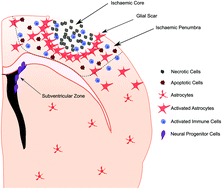Ischaemic stroke remains one of the leading causes of death and disability worldwide, without any long-term effective treatments targeted at regeneration. Limitations of existing and proposed cell- and drug-based therapies have led to the investigation of hydrogel-based strategies for new and improved therapies. They aim to enhance the intrinsic repair mechanisms, improve engraftment of therapeutic stem cells, and deliver drugs/biologics in a controlled manner in the post-stroke brain. The following article will explore the pathophysiology of stroke, and the need for injectable hydrogels in neural tissue engineering, focusing on a class of injectable hydrogels based on self-assembling peptides (SAPs). The various types of these materials will be addressed based on their mechanisms of self-assembly, including their novelties and benefits over conventional hydrogels, as well as recent experimental research that demonstrates the potential of these biomaterials in the treatment of stroke.
